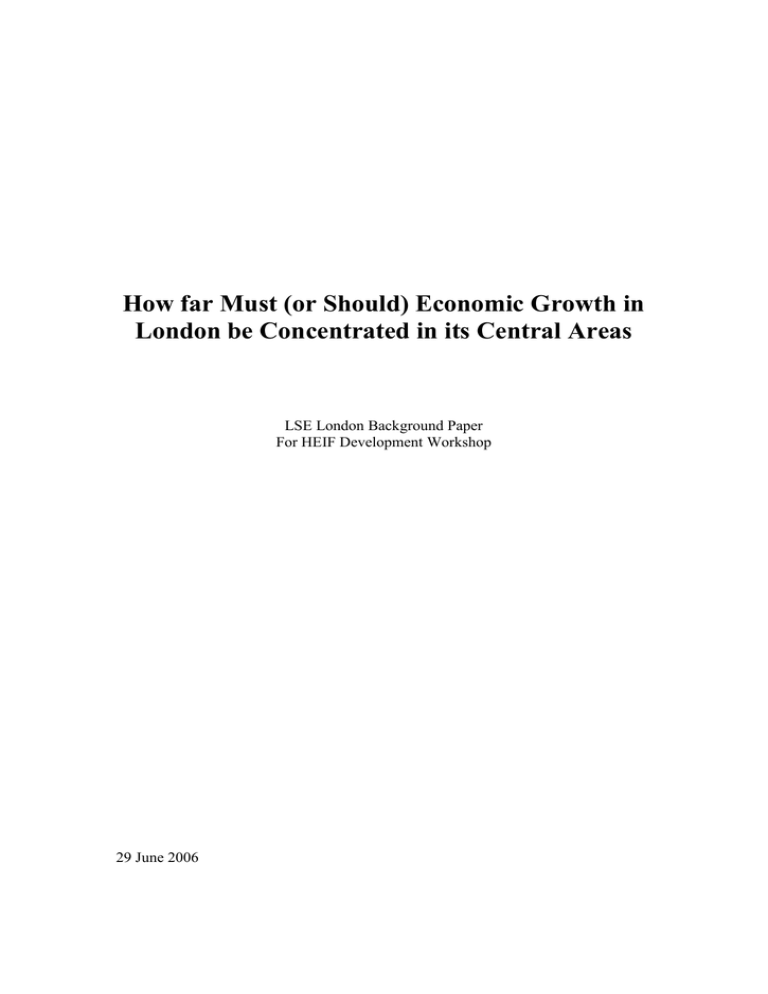How far Must (or Should) Economic Growth in
advertisement

How far Must (or Should) Economic Growth in London be Concentrated in its Central Areas LSE London Background Paper For HEIF Development Workshop 29 June 2006 1. Background Even 20 years ago, concerns about spatial disparities in employment change within the London region, related to the scale of job losses from inner boroughs, in a context of general employment decentralisation where outer boroughs were more or less holding their own, and the Outer Metropolitan Area around London was enjoying quite strong growth – though it was the areas beyond, in the Outer South East and parts of East Anglia which displayed the strongest growth. Between 1966 and 1981, for instance, employment in Inner London fell by 23%; that in Outer London fell by 5%; in the OMA it grew by 10%; while in the Outer South East it grew by 23%. In the next inter-censal period, to 1991, the pattern was not so very different, though London Docklands development was starting to produce faster growth in Tower Hamlets. This pattern was a source of concern, because inner London job losses were commonly blamed for the concentrations of unemployment (and associated deprivation) rates of inner areas – though research at the time found little connection between these (Buck et al., 1986). This pattern has clearly changed, and though faster growth rates continue to be experienced in outer parts of the Greater South East, the 1990s saw a major turnaround in the growth performance of much of inner London, across a substantially extended Central Business District, leaving Outer London as the ‘ring’ displaying the most modest job increases (if not the decline evident in the earlier period. The disparity in growth performance within London is projected to continue in the employment projections produced by GLA Economics for the London Plan review (Melville, 2006), as it was in those prepared for the Plan itself (GLA, 2002). Comparison with forecasts produced for SEERA and EERA indicates that the number of jobs in the ring outside London IS also expected to continue growing at a much faster rate than in Outer London. The immediate stimulus for this seminar was a renewed expression of concern from non-Central London borough/sub-regional partnerships about the relationship of this to further faster growth forecast for neighbouring sub-regions of the Eastern/South Eastern regions. More specifically, we might distinguish three kinds of concern: how realistic were the forecasts as a representation of the most likely outcomes of independent economic trends for areas within London; the potentially negative policy implications for Outer boroughs of adopting these projections as a basis for the revised/altered London Plan; and worries about the real (economic, social and environmental) consequences if employment growth in outer areas was as slow as predicted – particularly when population and households were projected to grow much faster. In this seminar we hope to address these questions, together with the logical followons of: why is job growth in Outer London so restrained by comparison to that in the areas on either side; and what kinds of initiative or development strategy could accelerate growth in some or all of the outer areas - if that were seen to be desirable. 2. The 2006 GLA Economics Borough Employment Forecasts The latest borough employment projections from GLA Economics (the third to be published, in May this year; Melville, 2006) envisage a growth of 503 thousand jobs in Inner London and 54 thousand in Outer London between 2003 and 2016, with further growth of 291 thousand and 118 thousand envisaged for the following decade. In both periods the projected rate of growth is substantially faster for Inner London, though less so after 2016. Whereas 56% of the base year employment is estimated to be in Inner London, 90% of the 2003-2016 growth is projected TO occur there, and 71% of the 2016-26 growth. In the shorter term the imbalance is even more marked, with Outer London employment projected to regain only 5 thousand of the 26 thousand jobs between 2001 and 2003 by 2011. The pattern is thus one with growth very heavily skewed toward Inner London (notably the City, Westminster and Tower Hamlets) up to 2011 and then starting to spread out rather more, until in the last 5 years covered by these projections the growth rates are nearly equal. In the case of the 2002 Plan employment projections for boroughs (GLA, 2002) there had been suggestions that the methodology might lead to a downward bias to the predictions for employment growth in the outer boroughs. The main basis for this was that the 2002 Plan forecasts had relied very heavily (70%) on assessments of potential commercial space availability, and that these were: (a) biased toward recognition of larger existing/known development sites, and those in areas of intensive regeneration planning (e.g. Gateway, as RTP had suggested in their report); and (b) overly deterministic, implicitly reflecting one planning strategy while not recognising any scope for alternatives to bring more space to the market in different areas. On the other hand, the 2002 forecasts took no direct account of the distribution of past employment trends, giving a weight (30%) only to how differences in industry mix (between fast growth/slow growth/declining sectors) would be expected to influence borough level employment growth – taking no account of the fact that in all/most sectors past trends had actually been less favourable in Outer London. The latest 2006 forecasts produced by GLA Economics for the Plan review have yet to be fullydocumented1, but are known to involve a different methodology (triangulation) involving three components: (1) potential commercial space availability/physical development potential (produced by Dave Lawrence of RTP, apparently on much the same basis as for the 2002 projections); (2) extrapolation (by Volterra) of actual borough level trends in shares of London employment in each sector; and (3) estimates of the impact of changes in accessibility (residents within 45 minutes travel), as a consequence of ongoing transport projects and those in the Mayor’s Transport Strategy. Of these elements the first two would imply a much larger share of employment growth in Inner as compared with Outer London, while the third does not really affect this split, but (for example) seems to allocate substantially more growth to Newham and less to City/Westminster. 1 A methodological paper is promised for the summer, together with a report on the space availability study. The basic approach was outlined in Melville (2005) The first element is arguably still somewhat biased against Outer London growth, and implicitly dependent on assumptions about policy/spatial strategy – while the third is explicitly tied to implementation of the Mayor’s transport strategy, both the realism and priorities of which have come into question, in ways that might significantly affect the expected spatial distribution of employment growth. At the broad level of relative growth rates in Inner/Outer London, however, neither the new projections nor their predecessors are much out of line with trends over the past 15 years or so. And, in our view, reasonable arguments about the overall London projections would be more likely to lead to lower than to higher growth figures. There seems to be no simple technical basis, therefore, for suggesting that employment growth projections for Outer London as a whole are too low. The more obvious questions are: (a) why has growth been generally weaker in the outer areas; (b) what difference would alternative planning/transport investment assumptions make to expectations about employment in these areas; (c) what more specific actions would significantly strengthen performance in the outer areas; and (d) why/how does it matter if large areas of outer London show little/no employment growth – this being the expectation rather than significant net job losses , and what kinds of policy response would be worth considering. 3. Factors Underlying Weaker Growth Performance in Outer London Over the past 15 years or so, employment in Outer London seems to have grown on average by about 0.3% per year – significantly below the UK average, and only about one third of the average growth rates in two adjoining ‘rings’ of the metropolitan region - Inner London and the Outer Metropolitan region. This pattern is illustrated in Table 1 using data from the last two Population Censuses (as one of the more reliable sources of London employment data). Over this period they indicate that about 20% only of London employment growth (or 12% of that in the wider metropolitan region) occurred in the outer boroughs. Long term estimates based on the Labour Force Survey or the Annual Business Inquiry and coming further up to date suggest a broadly similar imbalance between growth rates in Outer as against Inner London (and/or, for the ABI, the Outer Metropolitan Area). One reason is that the outer boroughs still have rather more employment in goods producing/handling sectors (declining generally and especially in London) and less in business (or cultural) services (growth has been fastest). This is a diminishing source of disadvantage, however, as there are fewer manufacturing jobs left to lose. This transition occurred earlier in Inner London, where these sectors were very largely squeezed out in the 1970s and 1980s. Beyond this, most of Outer London seems to ‘fall between two stools’ economically, able to match neither the (distinct kinds of) competitive advantage available in central areas – with their very strong local concentrations of specialist services, excellent access to rail services, both to access the UK market and the wider region’s skilled labour pools, and infrastructure support for regenerated ex-transport sites – or in the Outer Metropolitan Area – with more abundant space, locally resident skill concentrations, superior motorway/port (and even airport) access, and second-best rail access both nationally and to central London. This interpretation was strongly supported by the mid-1990s TeCSEM survey of location factors and judgements among businesses in London and in the Thames Valley (Cheshire and Gordon, 1994; Gordon, 1997). At a simple level the questions are then: how relative disadvantages can be mitigated; what distinct niche positions the particular combinations of assets/ accessibilities in various Outer London centres can build competitive strength in; what critical inherited constraints on performance need to be overcome; and how far is long run reinforcement of the outer economies, to secure the growth envisaged after 2016, compatible with a period of stagnation before then, when attention as well as growth is focused on the central areas. 4. Why Might Slow Growth in Outer London be a Cause for Concern ? Overall the forecasts for sub-regions of Outer London involve stability/slow growth rather than actual decline (even in the early years), with any potential crises limited to specific sectors (as in the past). If growth in the wider region proceeds as expected, the outer areas should not experience net job losses. Commuting links between sub-labour markets in the metropolitan region are such that relative employment trends in parts of the region (even in relation to groups of less skilled/less mobile workers) have rather little significance for local employment rates – which are, in any case, still significantly better in Outer London than in most inner areas (very largely as a function of who lives where, and the personal strengths/limitations they are seen as possessing). On the supply-side, putting these new workplace growth forecasts alongside residence-based estimates from the (Cambridge Econometrics et al, 2005) London/South East Commuting Study (undertaken for the Assemblies and RDAs) points to some much increased imbalances with apparently strong implications for commuting (see Table 2). Employment among residents of Outer London is projected to grow by very much more than workplace employment in the area (indeed by as much absolutely as in Inner London, though at a slower percentage rate). As in the 1990s, this implies increased out-commuting from Outer London both to Inner London (mostly be public transport) and to the Outer Metropolitan Area (much of this by car). Though a continuation of past trends, this raises questions both about capacity constraints and about sustainability, in terms of growth of non-local car traffic. The other potential reason for concern about continuation of the slow growth trends relates to the potential for further weakening of the competitive position of outer London centres as (and where) they fail to develop their own concentrations of economic strength and appropriate infrastructure to sustain these. Except at the ends of the extended east-west Central Business District and around Heathrow, the options for a more polycentric form of development within London (matching that in the wider region) would seem liable to be foreclosed over the Plan period, unless positively taken up within the revised SDS. 5. Agenda for the Seminar The intentions of this seminar are: initially to establish a common understanding in relation to the forecasting issues outlined in the background section above (particularly via discussion of Bridget Rosewell and Dave Lawrence’s presentations, as key people involved in the forecasts) – and to understand the basis for the shifting distribution of projected growth over the extended Plan period; o This might reasonably lead to questions as to whether GLA/GLA Economics should be pressed (by the Assembly) to produce variant projections, incorporating particularly alternative assumptions about the rate/pattern of transport improvements (given that GLA Economics’ methodology can simply be adapted to alternative assumptions). and then to focus attention on understanding: o why recent growth in London has been so centralised; o whether this is entirely a good thing; o what could make a difference to the distribution of actual growth across London; and o how this relates to actual or potential elements of the Mayor’s various strategies, including the Plan but also the Transport and Economic Development Strategies. References Buck, N. , Gordon, I. and Young, N. (1986) The London Employment Problem, Cambridge: Cambridge University Press. Cambridge Econometrics et al. (2005) Commuter Flows in London and the Wider South East 2001 to 2016/2021, London: Corporation of London for GLA/LDA/SEERA/SEEDA/EERA/EEDA Cheshire, P. and Gordon, I (1995) ‘Change and spatial specialisation in the South East region’, in Cheshire and Gordon (eds.) Territorial Competition in an Integrating Europe, Aldershot: Avebury. Gordon, I.R. (1996) ‘Territorial Competition and Locational Advantage in the London Region’, American Association of Geographers Annual Meeting, Charlotte, NC. Greater London Authority (2002) Demand and Supply of Business Space in London, SDS Technical Report 21, London: GLA Melville, D. (2005) ‘Triangulation and Employment Projections’, London: GLA Economics [http://www.london.gov.uk/mayor/economic_unit/docs/triangulationemployment-projections.pdf] Melville, D. (2006) ‘Borough employment projections to 2026’, Current Issues Note 9, GLA Economics [ www.london.gov.uk/mayor/economic_unit/ docs/current_issues_note_9.pdf] Table 1 Employment Change By workplace and Residence 1991-2001 (Census of Population) Employment by Employment by Net Workplace Residence Commuting 1991% 1991% 1991 2001 change 1991 2001 change 1991 2001 change change Inner London 1809 359 19.8 957 292 30.5 852 919 Outer London 1540 97 6.3 1869 187 10.0 -329 -419 London Fringe 801 120 15.0 909 81 8.9 -108 -69 Rest of Outer Metro Area 1544 224 14.5 1728 172 10.0 -184 -132 London Metropolitan Region (total) 5694 800 14.0 5463 732 13.4 231 299 Table 2 Projected Employment Change By workplace and Residence 2001-2016 (GLA Economics May2006 for London employment by workplace; other figures from Cambridge Econometrics, 2005) Employment by Workplace 2001-16 2001 Change (Census) (GLAEcon & CE) % change Employment by Residence Net Commuting 2001% 2001 16 change 2001 (Census) change (CE) (CE) Inner 2168 565 0.22122 1249 189 15.1 919 London Outer 1637 28 0.01406 2056 186 9 -419 London London 921 119 12.9 990 57 5.8 -69 Fringe Rest of Outer Metro 1768 243 13.7 1900 123 6.5 -132 Area London Metropolitan Region 6494 955 14.7 6195 555 6.2 299 (total) Note: The GLA Economics workplace forecasts are actually 2003-based; changes are presented here against a 2001 base, for comparability both with the 2002 London Plan projections and the Cambridge Econometrics projections for employment by residence (in all zones) and by workplace (in the OMA), which take Census workplace and residence data as their base. 2016 1295 -577 -7 12 699



